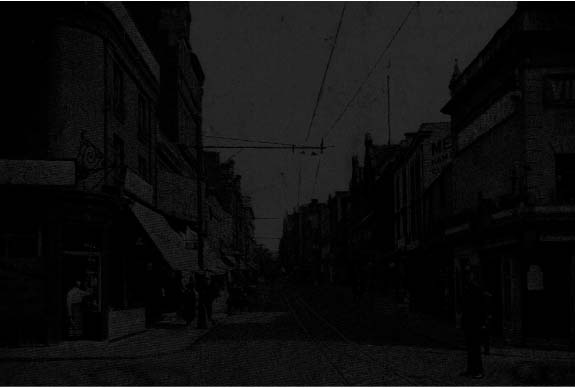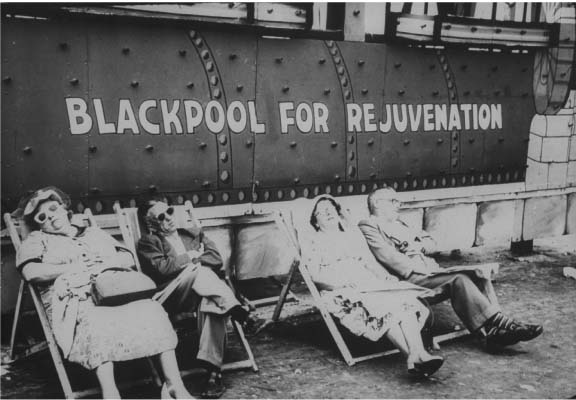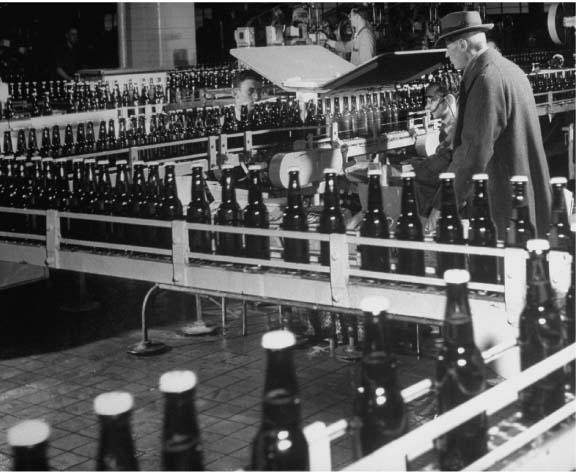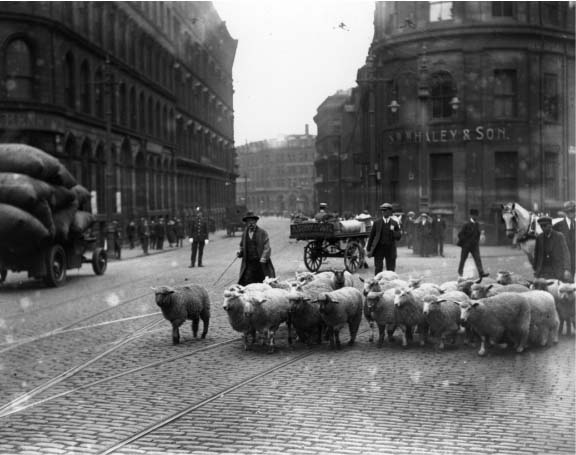Lyttelton's Britain (23 page)
Read Lyttelton's Britain Online
Authors: Iain Pattinson

Blackpool Illuminations, December 1939
(under wartime blackout regulations)
With the growth in visitors, the North Pier was built in 1863 and its grand opening was celebrated with much drinking and revelry. Some were reported to have dived off the end despite many warnings, before coming back a few hours later to try again with the tide in.
This was followed by the Central Pier and the South Pier and, in 1902, construction of yet another was begun. Intended to stretch two miles from the promenade, by the time it reached the railway station, the builders realised they’d got the plans the wrong way round.
To compete for trade lost to the piers, the Winter Gardens decided to build a huge wheel measuring 220 feet in diameter. This spun slowly for the crowds for several years, but was never a great success and finally closed in 1926 when the hamster died.
The first of Blackpool’s famous decorative illuminations were erected in Christmas 1912, when Princess Louise opened the Princess Parade. Her Royal Highness was then invited to inspect the seven miles of bulbs strung on poles, until she found the dud one that was stopping all the others from working.
In the 1930s, George Formby was a regular favourite at the Winter Gardens with his trademark gap teeth and ukulele, but stunned everyone when, in 1975, he came out of retirement in Kinshasa to fight Muhammad Ali for the World Heavyweight title.
It’s in Blackpool that Jaguar cars were first built. Originally called the ‘Swallow Sidecar Company’, Jaguar’s most successful model of the 1930s was a sports car known as the ‘S. S. One Hundred’. However with the onset of war, this was thought to be inappropriate, and after much head scratching, they changed the name to the ‘Two-and-Half-Litre Drop-Head Gestapo’.
Blackpool has in recent years become world-renowned as a conference centre, and is the traditional home of the TUC’s Annual Conference. It was there in 1997 that they took the historic decision to scrap the old system of block votes, after one delegate ordered a hot drink and the staff delivered three point five million white coffees with three sugars.

The
You and Yours
roadshow visits Blackpool

H
ALIFAX
is a fine Yorkshire town boasting a rich and varied history. The name ‘Halifax’ is said to derive from a corruption of ‘Holy’ and ‘Face’, as local legend has it that the head of John the Baptist was buried in Halifax after his execution. In fact, several other Yorkshire towns are also rumoured to hold various of St John’s body parts. Knaresborough is said to house his knees, while the people of Coxwold keep very quiet.
At the dawn of the Industrial Revolution, Halifax was a forward-thinking metropolis and had a police force even before London. As early as 1787 the town had constables on the beat, who, although armed with muskets, were considered both helpful and affable. But it was best not to ask one to get your cat out of a tree.
The need for new housing in Halifax during the Industrial Revolution prompted the formation of building societies. The first was suggested in 1853 by Samuel Hanson, a local businessman, who had become so disillusioned depositing his money with traditional banks, that it began to affect his marriage. As his wife relates in her diaries, Hanson would put it in, lose interest and take it out again.
A noted Halifax resident was William Herschel, the 18th Century lens-maker and astronomer. When King George III
visited his observatory there, Herschel proudly proclaimed: ‘With this powerful telescope, Your Majesty, I have discovered a new planet, and predict that in the future, men will travel a great distance to examine the rings around Uranus’.
Jesse Ramsden, the noted maker of theodolites was born near Halifax, and it was his pioneering work that produced the Ordnance Survey roadmaps we know today. At his funeral in 1837, mourners were surprised to see Ramsden’s widow trying to read the lesson upside down.
Another scientist born in Halifax was Henry Briggs, widely considered to be one of the three greatest mathematicians of the 17th Century, the other being John Napier. Briggs excelled at university, became the father of modern mathematics and went on to encourage the use of log tables to promote his range of garden furniture.
Percy Shaw, the inventor of the cat’s eye road marking, was born in Halifax in 1890. A pioneer of motoring, it’s recorded that Shaw was inspired driving home one night when he spotted the reflection from the eyes of a cat walking in the road. The following night the cat was walking the other way, and Shaw invented the furry pencil sharpener.
The former High Court Judge, James Pickles, hails from Halifax. Pickles’ controversial career often made headline news. He found notoriety by suggesting that young women might become pregnant between arrest and sentencing to avoid a prison sentence. Unsurprisingly, few took up his offer.
The actor Roger Moore used to live in nearby Hebden Bridge. Moore first found fame on TV as
Ivanhoe
and then as
The
Saint
, but moved into the movies where he became known as our eighth favourite James Bond.

When
I’m Sorry I Haven’t A Clue
visited Halifax, suppliers geared up to cater for Barry Cryer’s special dietary requirements

B
RADFORD
is not only a tiny, picturesque village of mellowed bath stone cottages, nestling along the banks of the River Avon, but is also a hundred and fifty miles away in Wiltshire. However, the Yorkshire city of Bradford boasts a rich and varied history.
The name of the town is derived from ‘Broad Ford’, because of a local river crossing which was wide and convenient for dumping stolen Escorts. Originally a small Saxon village, little of the original settlement survives apart from a fine 15th Century cathedral, which took 194 years to complete. A construction period of nearly two centuries may seem ridiculous to us, but of course builders were a lot quicker in those days.
The town’s prosperity grew thanks to the wool trade, and during the Royalist siege of the Civil War, balls of wool were even hung on the city walls to protect them from canon-fire. This proved largely ineffective, as the Royalists hurled large numbers of playful kittens to bat them out of the way.
The productivity of the woollen mills was raised beyond measure in 1798 with the arrival of steam power. The engineer James Watt, who having noticed how the steam from a boiling kettle forced its lid open, was inspired to build his labour-saving machine. With reciprocating three-foot piston cylinders connected by a massive cast-iron cantilever beam, Watt had created the world’s first seven-ton Teasmaid.

Eager BBC listeners are ushered to an early recording of
Quote Unquote
Bradford’s heritage lies in the industrial growth of the Victorian era. Thanks to the local abundance of coal and iron ore, the city boasts many educational establishments of technical excellence, producing the world’s finest mechanical, electrical and civil engineering graduates, who these days go on to work in some of Cardiff’s finest call centres.
Every industry at one time flourished in Bradford, and in 1952, the Bradford-manufactured Jowett Javelin motor car won the prestigious non-stop Le Mans 24-hour race, possibly the last time a British-built motor car ran for a whole day without breaking down.
Bradford was also known for the excellence of its Edwardian Theatre, which pioneered pantomime, music hall and classical drama. It was in Bradford in 1905 that the great actor-manager Sir Henry Irving, then in the twilight of his life, made his last performance. Having given a hushed audience his bloody Thomas Beckett murder scene, Irving sadly collapsed and died. It was most unfortunate, as he was actually playing Widow Twanky at the time.
Famous names associated with Bradford include the three Brontë sisters, who lived and worked there. Anne Brontë wrote
The Tenant of Wildfell Hall
under the pen name ‘Acton Bell’, Charlotte wrote
Jane Eyre
as ‘Curer Bell’, and most famous of all there was Emily, who wrote
Wuthering Heights
under the penname ‘Kate Bush’.
The composer Frederick Delius was born in Bradford. He of course wrote
Sonata for Strings
and
Dance Rhapsody No. 2
, but is perhaps best remembered for
Delius – How To Cheat At Cooking
.